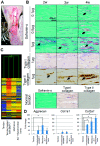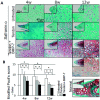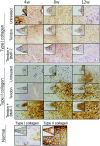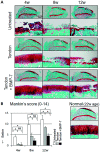Transplantation of Achilles tendon treated with bone morphogenetic protein 7 promotes meniscus regeneration in a rat model of massive meniscal defect
- PMID: 23897174
- PMCID: PMC4034586
- DOI: 10.1002/art.38099
Transplantation of Achilles tendon treated with bone morphogenetic protein 7 promotes meniscus regeneration in a rat model of massive meniscal defect
Abstract
Objective: This study was undertaken to examine whether bone morphogenetic protein 7 (BMP-7) induces ectopic cartilage formation in the rat tendon, and whether transplantation of tendon treated with BMP-7 promotes meniscal regeneration. Additionally, we analyzed the relative contributions of host and donor cells on the healing process after tendon transplantation in a rat model.
Methods: BMP-7 was injected in situ into the Achilles tendon of rats, and the histologic findings and gene profile were evaluated. Achilles tendon injected with 1 μg of BMP-7 was transplanted into a meniscal defect in rats. The regenerated meniscus and articular cartilage were evaluated at 4, 8, and 12 weeks. Achilles tendon from LacZ-transgenic rats was transplanted into the meniscal defect in wild-type rats, and vice versa.
Results: Injection of BMP-7 into the rat Achilles tendon induced the fibrochondrocyte differentiation of tendon cells and changed the collagen gene profile of tendon tissue to more closely approximate meniscal tissue. Transplantation of the rat Achilles tendon into a meniscal defect increased meniscal size. The rats that received the tendon treated with BMP-7 had a meniscus matrix that exhibited increased Safranin O and type II collagen staining, and showed a delay in articular cartilage degradation. Using LacZ-transgenic rats, we determined that the regeneration of the meniscus resulted from contribution from both donor and host cells.
Conclusion: Our findings indicate that BMP-7 induces ectopic cartilage formation in rat tendons. Transplantation of Achilles tendon treated with BMP-7 promotes meniscus regeneration and prevents cartilage degeneration in a rat model of massive meniscal defect. Native cells in the rat Achilles tendon contribute to meniscal regeneration.
© 2013 The Authors. Arthritis & Rheumatism is published by Wiley Periodicals, Inc. on behalf of the American College of Rheumatology.
Figures






Similar articles
-
Synovial mesenchymal stem cells promote meniscus regeneration augmented by an autologous Achilles tendon graft in a rat partial meniscus defect model.Stem Cells. 2015 Jun;33(6):1927-38. doi: 10.1002/stem.2030. Stem Cells. 2015. PMID: 25993981 Free PMC article.
-
Transplantation of Parathyroid Hormone-Treated Achilles Tendon Promotes Meniscal Regeneration in a Rat Meniscal Defect Model.Am J Sports Med. 2022 Sep;50(11):3102-3111. doi: 10.1177/03635465221112954. Epub 2022 Aug 1. Am J Sports Med. 2022. PMID: 35914290
-
Intra-articular Injected synovial stem cells differentiate into meniscal cells directly and promote meniscal regeneration without mobilization to distant organs in rat massive meniscal defect.Stem Cells. 2009 Apr;27(4):878-87. doi: 10.1634/stemcells.2008-0616. Stem Cells. 2009. PMID: 19350690
-
Meniscal substitutes--human experience.Scand J Med Sci Sports. 1999 Jun;9(3):146-57. doi: 10.1111/j.1600-0838.1999.tb00445.x. Scand J Med Sci Sports. 1999. PMID: 10380271 Review.
-
Meniscal substitutes--animal experience.Scand J Med Sci Sports. 1999 Jun;9(3):141-5. doi: 10.1111/j.1600-0838.1999.tb00444.x. Scand J Med Sci Sports. 1999. PMID: 10380270 Review.
Cited by
-
Synovial mesenchymal stem cells promote meniscus regeneration augmented by an autologous Achilles tendon graft in a rat partial meniscus defect model.Stem Cells. 2015 Jun;33(6):1927-38. doi: 10.1002/stem.2030. Stem Cells. 2015. PMID: 25993981 Free PMC article.
-
Advances in biomechanical and biochemical engineering methods to stimulate meniscus tissue.Am J Transl Res. 2021 Aug 15;13(8):8540-8560. eCollection 2021. Am J Transl Res. 2021. PMID: 34539978 Free PMC article. Review.
-
The potential of using semitendinosus tendon as autograft in rabbit meniscus reconstruction.Sci Rep. 2017 Aug 1;7(1):7033. doi: 10.1038/s41598-017-07166-z. Sci Rep. 2017. PMID: 28765605 Free PMC article.
-
Biochemical Stimulus-Based Strategies for Meniscus Tissue Engineering and Regeneration.Biomed Res Int. 2018 Jan 17;2018:8472309. doi: 10.1155/2018/8472309. eCollection 2018. Biomed Res Int. 2018. PMID: 29581987 Free PMC article. Review.
-
Biomechanically, structurally and functionally meticulously tailored polycaprolactone/silk fibroin scaffold for meniscus regeneration.Theranostics. 2020 Apr 6;10(11):5090-5106. doi: 10.7150/thno.44270. eCollection 2020. Theranostics. 2020. PMID: 32308770 Free PMC article.
References
-
- Walker PS, Erkman MJ. The role of the menisci in force transmission across the knee. Clin Orthop Relat Res. 1975:184–92. - PubMed
-
- Walsh CJ, Goodman D, Caplan AI, Goldberg VM. Meniscus regeneration in a rabbit partial meniscectomy model. Tissue Eng. 1999;5:327–37. - PubMed
-
- Burks RT, Metcalf MH, Metcalf RW. Fifteen-year follow-up of arthroscopic partial meniscectomy. Arthroscopy. 1997;13:673–9. - PubMed
-
- Englund M, Roos EM, Roos HP, Lohmander LS. Patient-relevant outcomes fourteen years after meniscectomy: influence of type of meniscal tear and size of resection. Rheumatology (Oxford) 2001;40:631–9. - PubMed
Publication types
MeSH terms
Substances
LinkOut - more resources
Full Text Sources
Other Literature Sources

